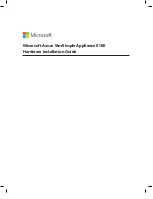
System status details
•
System Health—The server health indicator. This value summarizes the condition of the monitored subsystems, including
overall status and redundancy (ability to handle a failure). Lack of redundancy in any subsystem at startup will not degrade
the system health status. The possible values are
OK, Degraded, and Critical.
To navigate to the
Health Summary page, click the System Health link.
•
iLO Health—The iLO health status, which is based on the combined results of the iLO diagnostic self-tests. The possible
values are
OK and Degraded.
To navigate to the
Diagnostics page, click the iLO Health link.
•
iLO Security—The iLO security status, which is based on the combined results from the Security Dashboard page. The
possible values are
OK, Ignored, and Risk.
To navigate to the
Security Dashboard page, click the iLO Security link.
•
Server Power—The server power state (ON or OFF).
To access the virtual power button features, click the
Server Power icon.
To navigate to the
Server Power page, click the Server Power link.
•
UID Indicator—The state of the UID LED. The UID LED helps you identify and locate a server, especially in high-density
rack environments. The possible states are
UID ON, UID OFF, and UID BLINK.
If the iLO Service Port is in use, the
UID BLINK status includes the Service Port status. The possible values are UID BLINK
(Service Port Busy), UID BLINK (Service Port Error), and UID BLINK (Service Port Finished).
To turn the UID LED on or off, click the UID Indicator icon, click the UID control at the top of the iLO web interface, or use
the UID buttons on the server chassis.
When the UID is blinking, and then it stops blinking, the status reverts to the previous value (
UID ON or UID OFF). If a new
state is selected when the UID LED is blinking, that state takes effect when the UID LED stops blinking.
CAUTION: The UID LED blinks automatically to indicate that a critical operation is underway on the host, such as
remote console access or a firmware update. Do not remove power from a server when the UID LED is blinking.
•
Trusted Platform Module or Trusted Module—The status of the TPM or TM socket or module.
The possible values are
Not Supported, Not Present, or Present-Enabled.
Trusted Platform Modules and Trusted Modules are computer chips that securely store artifacts used to authenticate the
platform. These artifacts can include passwords, certificates, or encryption keys. You can also use a TPM or TM to store
platform measurements to make sure that the platform remains trustworthy.
On a supported system, ROM decodes the TPM or TM record and passes the configuration status to iLO.
•
Module Type—The TPM or TM type and specification version. The possible values are TPM 1.2, TPM 2.0, TM 1.0, Not
Specified, and Not Supported. This value is displayed when a TPM or TM is present on a server.
•
microSD Flash Memory Card—The status of the internal SD card. If present, the SD card capacity is displayed.
•
Access Panel Status—The state of the access panel. The possible states are OK (the access panel is installed) and
Intrusion (the access panel is open). This value is displayed only on servers that are configured for chassis intrusion
detection.
•
iLO Date/Time—The internal clock of the iLO subsystem.
To navigate to the
SNTP Settings page, click the iLO Date/Time link.
72 Using HPE iLO 5
Содержание ProLiant e910
Страница 148: ...148 Customer self repair...
Страница 149: ...Customer self repair 149...
Страница 150: ...150 Customer self repair...
Страница 158: ...c Remove the PCIe riser board Right PCIe riser board Left PCIe riser board 158 Removal and replacement procedures...
Страница 182: ...UID unit identification UEFI Unified Extensible Firmware Interface 182 Acronyms and abbreviations...
















































